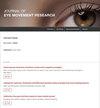Eye tracking in optometry: A systematic review
IF 2.8
4区 心理学
Q3 OPHTHALMOLOGY
引用次数: 0
Abstract
This systematic review examines the use of eye-tracking devices in optometry, describing their main characteristics, areas of application and metrics used. Using the PRISMA method, a systematic search was performed of three databases. The search strategy identified 141 reports relevant to this topic, indicating the exponential growth over the past ten years of the use of eye trackers in optometry. Eye-tracking technology was applied in at least 12 areas of the field of optometry and rehabilitation, the main ones being optometric device technology, and the assessment, treatment, and analysis of ocular disorders. The main devices reported on were infrared light-based and had an image capture frequency of 60 Hz to 2000 Hz. The main metrics mentioned were fixations, saccadic movements, smooth pursuit, microsaccades, and pupil variables. Study quality was sometimes limited in that incomplete information was provided regarding the devices used, the study design, the methods used, participants' visual function and statistical treatment of data. While there is still a need for more research in this area, eye-tracking devices should be more actively incorporated as a useful tool with both clinical and research applications. This review highlights the robustness this technology offers to obtain objective information about a person's vision in terms of optometry and visual function, with implications for improving visual health services and our understanding of the vision process.眼动追踪在验光中的应用:系统回顾
这篇系统的综述研究了眼动追踪设备在验光中的应用,描述了它们的主要特点、应用领域和使用的指标。采用PRISMA方法对三个数据库进行了系统检索。搜索策略确定了141份与该主题相关的报告,表明在过去十年中,眼动仪在验光中的使用呈指数级增长。眼动追踪技术至少应用于验光与康复领域的12个领域,主要是验光装置技术、眼部疾病的评估、治疗和分析。报告的主要设备是基于红外光的,图像捕获频率为60 Hz至2000 Hz。所提到的主要指标是注视、扫视运动、平滑追踪、微扫视和瞳孔变量。研究质量有时会受到限制,因为所提供的信息不完整,包括使用的设备、研究设计、使用的方法、参与者的视觉功能和数据的统计处理。虽然这一领域还需要更多的研究,但眼动追踪设备应该更积极地作为临床和研究应用的有用工具。这篇综述强调了这项技术在验光和视觉功能方面提供的关于一个人的视觉的客观信息的稳健性,这对改善视觉健康服务和我们对视觉过程的理解具有重要意义。
本文章由计算机程序翻译,如有差异,请以英文原文为准。
求助全文
约1分钟内获得全文
求助全文
来源期刊

Journal of Eye Movement Research
OPHTHALMOLOGY-
CiteScore
2.90
自引率
33.30%
发文量
10
审稿时长
10 weeks
期刊介绍:
The Journal of Eye Movement Research is an open-access, peer-reviewed scientific periodical devoted to all aspects of oculomotor functioning including methodology of eye recording, neurophysiological and cognitive models, attention, reading, as well as applications in neurology, ergonomy, media research and other areas,
 求助内容:
求助内容: 应助结果提醒方式:
应助结果提醒方式:


